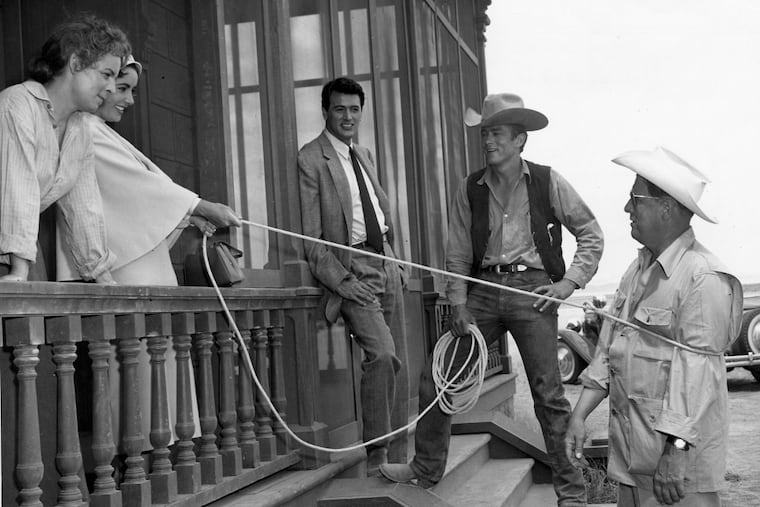'Giant': A giant book about a giant film
It's been called "the national film of Texas," and it's as big as the Lone Star State itself. George Stevens' 1956 epic, "Giant", clocks in at 3 hours and 21 minutes and featured three of the top stars of its time: Rock Hudson, Elizabeth Taylor, and James Dean.

Giant
Elizabeth Taylor, Rock Hudson, James Dean, Edna Ferber, and the Making of a Legendary American Film
By Don Graham
St. Martin's Press. 336 pp. $27.99
Reviewed by Gary M. Kramer
It's been called "the national film of Texas," and it's as big as the Lone Star State itself. George Stevens' 1956 epic, Giant, clocks in at 3 hours and 21 minutes and featured three of the top stars of its time: Rock Hudson, Elizabeth Taylor, and James Dean. Based on Edna Ferber's novel, the film has inspired everything from the hit TV series Dallas to Ed Graczyk's cult-play-turned-film Come Back to the Five and Dime, Jimmy Dean, Jimmy Dean.
Don Graham, a Texas writer and professor, digs into Giant like a wildcatter drilling for oil. He recounts the history of Giant's stars and creators, as well as the film's making and reception. He provides colorful tales with minimal Texas exaggeration and a plethora of facts and anecdotes, many of which were culled from other sources. For example, Ferber imagined Burt Lancaster as Jordan "Bick" Benedict, the role Hudson played, but the actor was never considered.
Graham spends complete chapters on how each of the three main actors were cast in the film, providing deep background about their lives and careers. There is much — arguably too much — discussion about talent agent Henry Willson, who helped create, er, launch, Hudson's career. Willson's efforts, which included quelling gay rumors about Hudson by having the beefcake star marry the agent's secretary, Phyllis Gates, are recounted in painstaking detail. They will likely please gossip-mongers. Taylor's career shift from child star to in-demand actress — she fought to play Leslie Benedict, a pioneer feminist heroine — is also addressed, along with her marriages, various ailments, and relationships with her costars.
But the bulk of Giant focuses on the unpredictable antics of Dean, who intrigued or annoyed the cast and crew before, during, and even after production; he died a few days before he was due to finish some dialogue looping and photos. Dean, who played Jett Rink, famously came late to the set, urinated in front of strangers, and focused on his own self-promotion, much to the chagrin of everyone around him. Hudson and Dean were rivals on and off-screen. Hudson was perhaps jealous of Dean's relationship with Taylor and was particularly irked by Dean's scene-stealing. Dean's meteoric rise is also recounted, and there is considerable speculation about his sexuality — gay, straight, bisexual, or asexual. In addition, his relationships with fellow method actors Dennis Hopper and Carroll Baker provide a sense of what the mercurial Dean was like with his peers.
Even though director George Stevens found Dean irritating, he acknowledged that the actor's instincts about his character were always spot-on, a testament to the late star's talent. Stevens, too, is a large focus of Giant, even though his name is missing from the subtitle. The filmmaker insisted on location shooting, and Graham skillfully describes the experiences of cast and crew filming for 38 days in Marfa, Texas, and how Stevens faced pressure to get the film done on time and under budget — neither of which happened. The behind-the-scenes tales — such as the director's insistence on filming his most personal sequence, the "Honda Knot" burial scene of Angel Obregon — provide a sense of Stevens' determination and achievement. The filmmaker won an Oscar for directing Giant, but the film lost in the nine other categories in which it was nominated.
The impact of Giant on audiences is also considered in the way the film presents its themes of racism, as well as how Dean's ghost haunts the film, and the melee caused by legions of fans at its premiere in New York. There are also some interesting asides about Glenn McCarthy and King's Ranch, the prototypes for the Benedict family and its ranch, Reata.
If this decent-size tome skimps on anything, it is the two dozen-plus black-and-white stills that are often placed three or four to a page. To shoehorn the images from a widescreen epic into practically passport-photo-size spaces is criminal.
But this is a minor complaint about a book that will satisfy fans of the film, and likely prompt readers to revisit Giant with all of the trials and tribulations the cast and crew experienced in mind.
Gary M. Kramer has published three books on cinema. He is a regular contributor to Salon, Philadelphia Gay News, Film International, and Cineaste, among other publications.